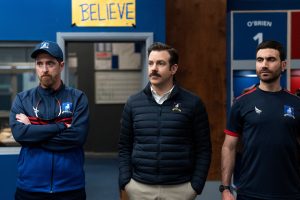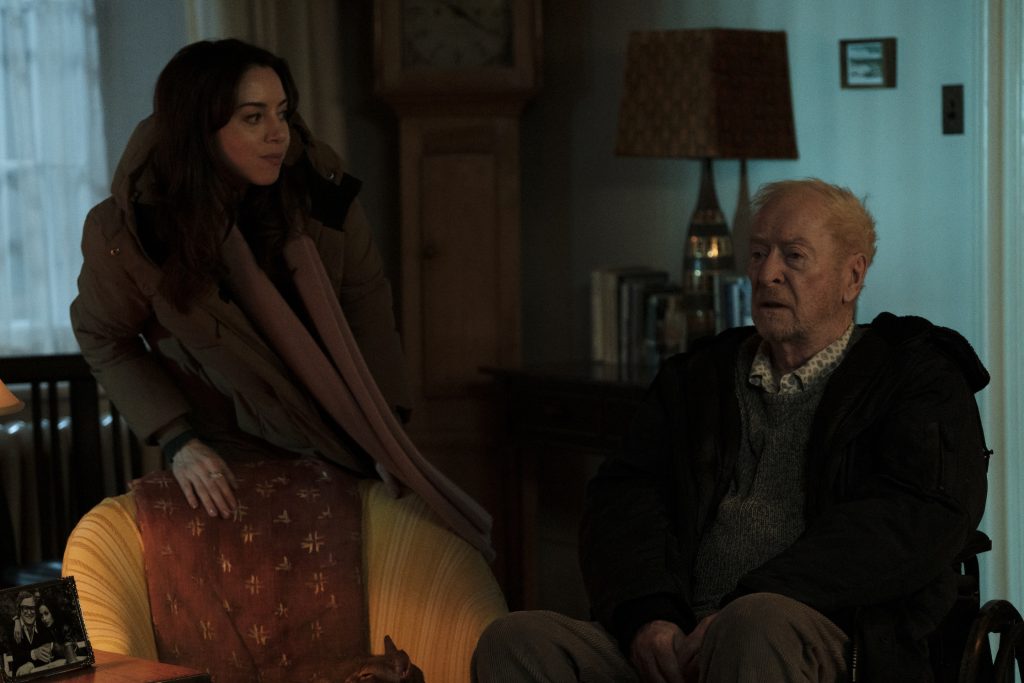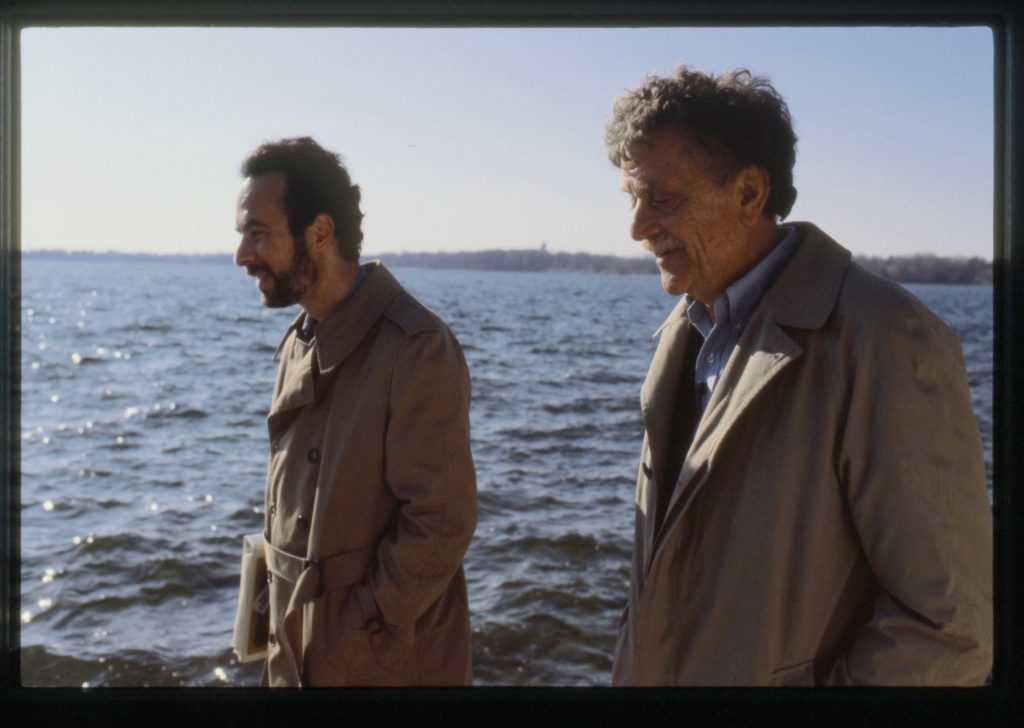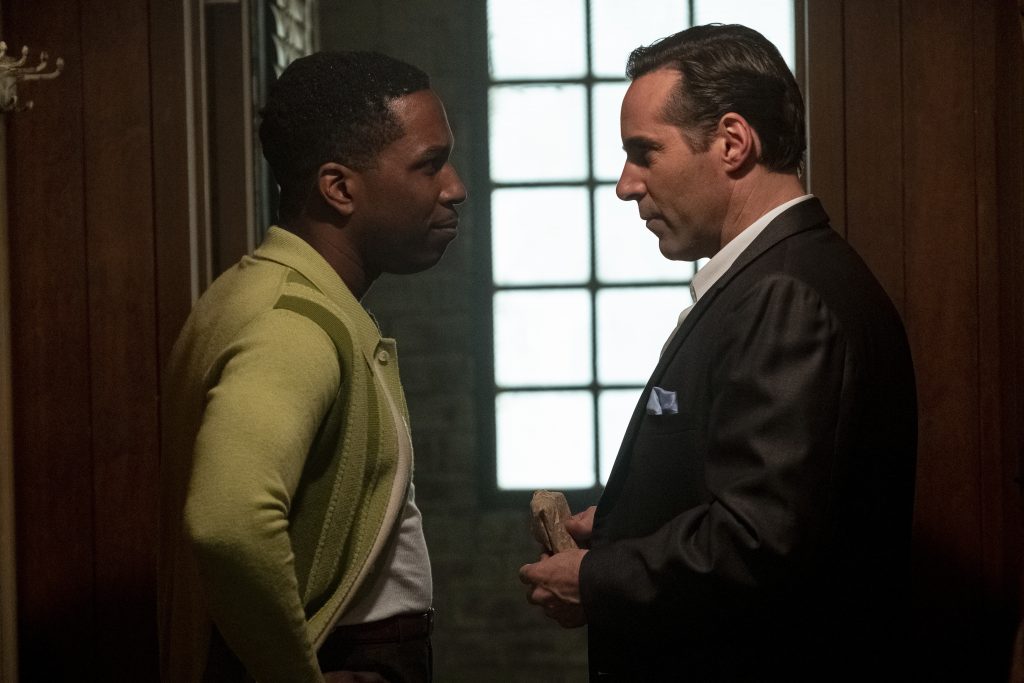January 15, 2022
by Carla Hay
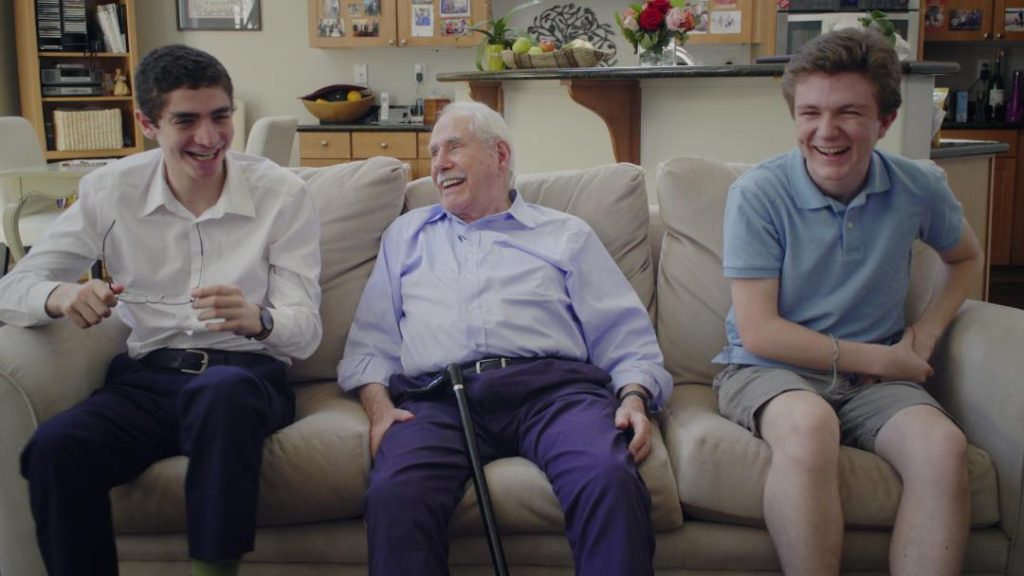
Directed by Skye Wallin
Culture Representation: Taking place in New York state, California, Detroit, Iowa, and Miami in 2019 and 2020, the documentary “American Gadfly” features a mostly white group of people (with some Asians) representing the working-class, middle-class and wealthy and who were connected in some way to Mike Gravel’s U.S. presidential campaign.
Culture Clash: Gravel, who was a progressive Democrat, made the unconventional decision to have teenagers run his presidential campaign.
Culture Audience: “American Gadfly” will appeal primarily to people who don’t mind watching documentaries about “progressive liberals” pretending to be “anti-establishment,” but these “anti-establishment progressive liberals” engage in very establishment and elitist practices to promote themselves.
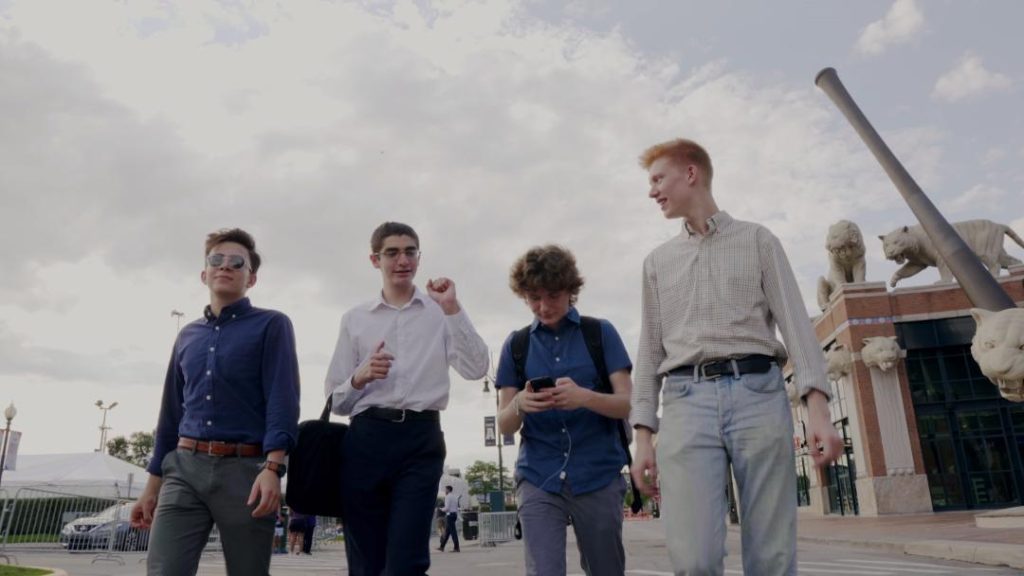
There’s a memorable line in The Who’s classic 1971 hit song “Won’t Get Fooled Again” that says, “Meet the new boss. Same as the old boss.” That’s the feeling you get from watching the self-congratulatory political documentary “American Gadfly,” when it comes to so-called progressive liberal Democrats acting a lot like the conservative Republicans they claim to be against.
It’s a very gimmicky, one-sided documentary about smug, teenage left-wing Democrats who came up with the idea to steer the 2020 U.S. presidential campaign of Mike Gravel, a self-described progressive liberal Democrat who was a U.S. Senator from Alaska from 1969 to 1981. They admit up front that their main goal wasn’t for Gravel to win the election but just to get Gravel in the Democratic Party primary debates.
If you know who made it onto the debate stages during that election race, then you already know if Gravel’s campaign failed in this goal. Gravel dropped out of the race in 2019, the year that the majority of this documentary was filmed. The movie’s end-credit scenes shows footage from 2020, when former members of the campaign team did video chats with Gravel during the COVID-19 pandemic quarantine.
Most of the teenagers who were running Gravel’s campaign were 17 to 19 years old at the time this documentary was filmed. Gravel gave the teens complete control over his social media accounts, where they posted everything under his name but using their own words. (The documentary shows plenty of these tweets and some Twitter reactions to these tweets.)
The teens whom Gravel put in charge of his campaign preach progressive politics but then don’t include any females, black people and Latinos in their campaign leadership. The teens give sanctimonious rants about Donald Trump’s rude campaigning, yet the teens do their own smear campaigns and vulgar insults against opponents too. The hypocrisy is disgusting.
“American Gadfly” (directed by Skye Wallin) is also a “bait and switch” documentary. The film tries to make it look like Gravel is the documentary’s main attraction, but Gravel actually doesn’t get as much screen time as he should, even though it’s his political campaign. Gravel is shown having only a few meetings with these teenagers whom he put in charge of the campaign. He treats them like students who were assigned a pet political project.
Gravel is edited in the movie as someone who occasionally checks in to voice his opinion. If you believe what’s in “American Gadfly,” he was a supporting player, not a leader, in his own political campaign, and the teenagers were really running the show. Gravel is never seen making personal appearances to the general public on the campaign trail.
Gravel doesn’t even make frequent video messages where he speaks directly to his supporters. Instead, his teenage campaign team concocts memes and amateurish promo videos about Gravel that they spread on the Internet. And then they complain that mainstream media won’t take the campaign seriously.
Gravel’s main claim to fame is being the first U.S. politician to put the Pentagon Papers on public record, when he read them out loud during his Subcommittee on Public Buildings and Grounds in 1971. He ran for U.S. president in 2008, and he made it to the presidential primary debates, but he ultimately dropped out of the race. Barack Obama got the Democratic Party nomination and won the election. Gravel was a Libertarian from 2008 to 2010, before going back to being a Democrat in 2010. Gravel died of multiple myeloma in 2021, at the age of 91.
It’s obvious from the beginning of this documentary that the teenagers were using Gravel as a “guinea pig” to get some experience working on a presidential campaign to further their own political ambitions. They knew that their ages and school commitments would be a big reason why they wouldn’t be accepted as campaign workers for a candidate who had a real shot of getting the Democratic Party nomination, so they chose a long-shot candidate instead.
The three guys who take most of the credit for convincing Gravel to run for U.S. president in 2019 are Henry Williams, David Oks and Elijah Emery, who all come from upstate New York. Williams is the biggest talker in the group and the one who apparently wrote most of the angry insults directed at Gravel’s opponents. Most of the Gravel campaigners’ vitriol was not aimed at Republicans but at Democrats whom they call “establishment Democrats,” such as Joe Biden, Kamala Harris, Cory Booker and Pete Buttigieg.
Oks is a self-described political nerd who’s the chief strategist of the Gravel campaign team. Emery is the most even-tempered and logical of the three, but Oks and Williams say behind Emery’s back (but in on-camera interviews) that Emery is too “idealistic” for the fiery brand of politics that Oks and Williams want to shove in people’s faces. Because Emery was in high school during the campaign, he wasn’t able to travel as much as Williams and Oks.
Three other members of the campaign team are featured in the documentary, but they don’t get as much screen time as Williams, Oks and Emery. Henry Magowan is the group’s treasurer. (The documentary never details now Gravel’s campaign money was spent.) Alex Chang is in charge of digital strategy. Jonathan Suhr is director of design. Chang and Suhr are both Asian and the only people of color chosen for this campaign leadership.
The decisions on who would lead everything in the campaign is basically a teenage version of an “old boys’ club.” Throughout the documentary, these so-called teenage progressive liberals from Generation Z proudly claim that their generation is going to shake things up and change politics by making everything more diverse and inclusive. And yet, they have absolutely no self-awareness of how bad they look in representing true progressive causes, by reverting to the same elitist “old boys’ club” mentality that they claim they want to change.
Needless to say, only males are invited to the Gravel campaign meetings where Gravel discusses his proposed policies and agendas for America. The Gravel campaign platform included Medicare for all; universal health care; paid family leave for all; eliminating the electoral college by having popular votes decide elections; legalizing marijuana in all U.S. states; decriminalizing prostitution; and making it a law to have equal pay for equal work. The documentary never shows or tells Gravel’s plan for how the U.S. government would pay for all these sweeping reforms.
The teen campaigners spend a lot of time bragging about how many “likes” and “retweets” they get on Twitter, and how many people they can reach on social media. And so, there is absolutely no excuse for this campaign team to have no females (who are 51% of the population in the U.S. and in the world) in any campaign leadership roles. And they can’t use the excuse that they couldn’t find any qualified females because these teens admit that they themselves are unqualified and inexperienced in this type of political campaign. If you want to know what male privilege and male entitlement look like, look no further than the Mike Gravel campaign team in “American Gadfly.”
You can’t expect to have credibility in policy issues about diverse representation when you can’t lead by example. Imagine being represented by a “progressive” politician who doesn’t seem to care that only males are leaders on his campaign team and that the gender representing the majority of the nation’s population is nowhere to be found in the campaign leadership. It’s beyond appalling.
Gravel obviously didn’t care enough about this blatant gender imbalance because he says in the documentary that his biggest complaint about how the teens were running the campaign was how they used the “f” curse word in their social media postings. Likewise, the “American Gadfly” filmmakers also didn’t notice or didn’t care to question why only males were the leaders of this campaign team. If this obvious sexism was addressed at any point by anyone in the documentary, it never made it into the movie. The people who are most likely to turn a blind eye to this hypocrisy are people who live in this type of hypocritical bubble.
At one point in the movie, Williams travels to California to meet Gravel in person for the first time. Oks can’t attend, but in his place, he sends a campaign worker named Benjamin Church, who is accompanied by someone named Rosaline Qi, who’s introduced as Church’s girlfriend. Over a meal at a restaurant, another young Asian woman is also seated at the table in this meeting with Gravel, but the documentary doesn’t explain who she is and what she’s doing there, as if the filmmakers think these young women don’t really matter at all.
How do we know that the filmmakers don’t care about these young women? Except for Qi saying hello to Gravel, these young women are not shown speaking at all during this conversation. In fact, women of color are nowhere to be found as important workers who were chosen for this campaign. This gross lack of diversity is like something you’d see in a campaign for a politician with a racist and sexist agenda.
Williams even has the tone-deaf arrogance to preach in the documentary about those who are oppressed: “It’s going to be poor people. It’s going to be minorities and immigrants—the same people who will always suffer if Trump is re-elected.” Meanwhile, the documentary shows these egotistical teens doing absolutely no personal outreach at all to the “oppressed” communities they claim to want to represent in the campaign. The teenagers seem to care most about hobnobbing with political insiders when they get invited to political events, or hanging out in restaurants with other privileged young “progressives.”
It’s not nitpicking to bring up these issues, because progressive liberals are the ones who complain the most and the loudest about the lack of diversity in American political leadership. Progressive liberals are the ones who push the hardest for laws against discrimination on the basis of gender, race, nationality, sexuality, disability, etc. But sometimes, there are people involved in politics who claim to be progressive liberals but who do not practice what they preach. The people they choose to put on their teams are not diverse at all.
A lot of “American Gadfly” is about Gravel’s all-male teenage campaign leaders approaching political campaigning as if insulting other candidates on social media (especially Twitter) is the most effective way to campaign. It’s the same political strategy that Trump used in his presidential campaigns, but these teens have such a “holier than thou” attitude, they can’t even see how much they sink to the same crude levels of the politicians they think are beneath them. These teens claim to be doing things better than politicians who are “old” and “elitist” when they’re using the exact same tactics as “old” and “elitist” politicians.
And these teen campaigners essentially boast about all the online bullying and childish name-calling that they dump on politicians whom they dislike. John Delaney is a particular target of their wrath because he was the Democratic candidate in the presidential campaign who had the closest (very low) polling numbers to Gravel. Delaney was therefore Gravel’s biggest obstacle to getting a place in a primary debate, which was limited to the top 20 candidates in Democratic National Committee-approved polls. The teen campaigners proudly take credit for getting “DropOutDelaney” to briefly trend on Twitter, but in the end, this fleeting Twitter meme didn’t help Gravel’s campaign.
However, there’s still some delusional egotism among these teen campaigners, because Suhr says in a campaign meeting: “What I’m hearing is that we’re an influencer’s influencer.” If you know how Gravel’s campaign turned out, then you’d be rolling your eyes at that statement. Influencing what? How to look like hypocritical left-wingers who act like petulant, “old boy network” conservatives?
Ironically, for a campaign team that did not include any females in leadership roles, the only Gravel political competitors who showed Gravel’s campaign any real support were two women: Democratic presidential candidates Tulsi Gabbard and Marianne Williamson. Much of the documentary is about the Gravel campaign team’s race against time to get 65,000 individual donors to the campaign, which is one of the Democratic National Committee’s requirements to be eligible for a presidential primary debate. Gabbard and Williamson (and some of their campaign staffers) also take the time to personally interact with Oks and Williams on the campaign trail.
Oks and Williams end up begging Gabbard and Williamson to help by asking Gabbard and Williamson to enlist their supporters to donate to Gravel’s campaign. Gabbard and Williamson graciously accommodate the Gravel campaign’s requests. Andrew Yang, another Democratic presidential candidate, shows some curiosity and interest in Gravel’s teen campaigners (who gush over him like fanboys), but ultimately Yang chooses not to give the Gravel campaign any real support.
Gravel actually told the teens to not associate the Gravel campaign with Yang, because Gravel says in a conference call that Yang’s proposed idea for the U.S. government to give $1,000 to everyone in the U.S. is “just crazy.” However, the teens are so dazzled by Yang, they ignore Gravel’s order to keep their distance from the Yang campaign. They try to ingratiate themselves with Yang, with the hope that Yang would lend his support to Gravel’s campaign. This effort backfired, and it’s an example of how Gravel’s teen campaigners didn’t respect Gravel’s authority and wanted unchecked power in this campaign.
“American Gadfly” is a perfect example of why so many people don’t respect certain “progressive liberals” who pompously lecture how they think they know what’s best for the United States and the world but don’t apply what they preach in their own lives. Some of these “progressive liberals” have a severe lack of racial diversity in whom they choose to have as friends, or whom they choose to hire if they’re in a position to hire people. This hypocrisy doesn’t apply to all progressive liberals, but it certainly applies to the “stars” of “American Gadfly.”
These teenagers rant against Donald Trump and conservative Republican politics. And yet, the documentary shows Williams, Oks, Emery and Magowan giddily asking conservative Republican politician (and former U.S. presidential candidate) Rick Santorum to pose for a photo with them, when they randomly see Santorum on the street and approach him almost like star-struck fans. It’s a moment where these young campaigners show that they care more about being close to establishment power than staying true to so-called “anti-establishment” progressive beliefs.
Gravel has such little interest in making personal appearances in front of his supporters, when Gabbard invites him to go to Miami to be in the audience of one of the presidential debates for the Democratic candidates, he gives his two tickets to Williams and Oks instead. It isn’t until after Gravel drops out of the race that he’s seen at any political event in this presidential race, when he goes to San Jose, California, to attend a rally for fellow progressive Bernie Sanders. Gravel ended up endorsing Sanders in this presidential race.
One of the many flaws of “American Gadfly” is how it doesn’t acknowledge this basic fact of politics: Social media cannot completely replace in-person campaigning. That’s why it looks so superficial and silly that these teenagers think it’s a big deal that comedian Sarah Silverman retweeted a comment that was made on Gravel’s Twitter account, when the campaign comments on that account were not written by Gravel in the first place. Twitter followers don’t mean much to a politician running for an elected office if most of those “followers” can’t or won’t vote for the politician.
The documentary shows major red flags that these teen campaigners are out of their league and completely inept when it comes to political campaign strategy that doesn’t involve the Internet. While some members of the team go to Iowa to do some “campaigning” (without Gravel, of course), Williams says: “I don’t know what shaking hands with brewsters in Iowa actually means, or if it corresponds to any serious political movement.”
Oks tries to cut the trip short and says, “If we were running a real campaign, I guess we’d be going around [meeting people in] Iowa. I wouldn’t really enjoy it.” Emery seems to understand that a politician who won’t campaign in person won’t be taken seriously and won’t go far in the race, so he comments to Oks: “What if people just enjoy talking to people they represent?”
Oks responds sarcastically, “What if people just enjoy hammering things into their legs?” Emery replies to Oks’ idiotic comment by saying, “Those are two different things.” They end up cutting the trip short out of frustration over lack of public interest in Gravel’s campaign. Once they get out of the bubble of the Internet, they have trouble handling the reality that campaigning in person is lot more work than they’re prepared to do.
It should be noted that Oks and Emery had this conversation while waiting at a politically liberal bookstore to give a talk about the campaign, but this speaking engagement is never shown in the movie. If they did go through with this speaking appearance, then the turnout was probably very low. Otherwise, it would’ve been in the documentary. So much for “widespread support” from social media followers.
In fact, there is absolutely no evidence in this documentary that Gravel would’ve been able to attract an impressive crowd in this campaign if he campaigned in person. That’s why the social media angle for this documentary is completely overrated. On the campaign trail, a few random strangers congratulate Gravel’s teen campaigners when these strangers find out who they are, but that’s about as much public recognition that they get from people in real life (not social media) who are not campaign workers.
Even how these teens approached Gravel to run for president shows they’re from a generation that can’t fully understand what it was like to communicate before the Internet existed. Williams says that they had to look up how to write a memo to get Gravel’s attention because they didn’t know what a memo was. It’s mentioned in the documentary that Oks was accepted to Oxford University, while Emery was accepted into Cornell University. It makes you wonder how what kind of high school education they had for them to be so ignorant about what a memo is or what a memo looks like.
“American Gadfly” is so insistent and narrow-minded in its agenda to make these teenagers look like cutting-edge political strategists (they’re not), the filmmakers only interviewed people who sing the praises of this amateur “old boys” political clique. Other people interviewed in the documentary include Whitney Gravel, Mike Gravel’s wife, who says she initially didn’t want Mike to run for U.S. president again because she was concerned that he was too old, but she changed her mind because of the enthusiasm of the teen campaigners. Also interviewed are Dave Weigel of The Washington Post; Jamie Keiles of The New York Times; Bernie Sanders senior staffer Keane Bhatt; and a student classmate named Miranda Luiz.
And where are the parents of these teenagers? Only two of them are interviewed in the documentary, and they both give brief comments. Anne Williams, Henry’s mother, is fully supportive of what he’s doing. Bettina Weil, Oks’ mother, has some reservations when she says of the Gravel campaign team: “They were amazing with social media, etc. Criticizing politicians—I was not happy about that.”
In the documentary, Henry Williams says his father expressed concern that all the hateful comments that Henry has written about fellow Democrats could backfire in the future if Henry wants to pursue a political career. Henry says, “I told him, ‘If I can’t speak truth to power, or if I’m too afraid to, to protect my future or my career, then am I worth anything at all?'” It’s too bad that Henry Williams and the rest of the campaign leaders on the team aren’t shown actually doing any work in communities that need help, because their idea of activism is promoting themselves by using a privileged politician’s name on social media.
“American Gadfly” is a misguided documentary that lets its “stars” off the hook too easily when it comes to many problematic issues. For a better look at how Gen Z progressive liberals from America are speaking truth to power and engaging in the political process to make real changes—instead of perpetuating old systems in a self-promoting way—watch any of these documentaries on Gen Z activists who are part of truly inclusive and diverse teams: “Us Kids,” “We Are the Radical Monarchs” or “The Day I Had to Grow Up.”
Gravitas Ventures released “American Gadfly” on digital and VOD on January 4, 2022.






